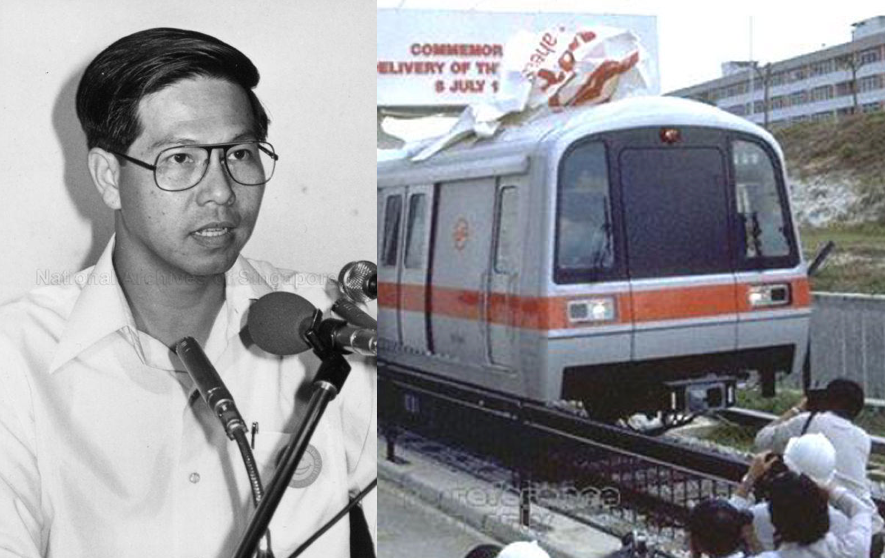The MRT system is presently no stranger to controversy with its frequent disruptions that are a bane to commuters.
When it does actually run smoothly, however, it is an affordable and efficient way to get round our island.
Bearing this in mind, it is perhaps hard to imagine that the MRT might not have even been built, if not for the late Ong Teng Cheong who had tenaciously pushed for its construction.
Early beginnings in 1967
The idea of the MRT system was first proposed in 1967 by the planners of the State and City Planning Project, which had been initiated in the same year to guide the physical development of Singapore.
Singapore was only into its second year of independence back then.
A team of planners, with the help of the United Nations Development Programme, peered very hard into the future and predicted that a transportation system based on buses alone would fail by 1992.
So, an MRT system aimed to serve as an island-wide public transport system to improve connectivity between the city centre and residential areas, as well as to ease traffic congestion and reduce pollution.
Ong Teng Cheong, who was then an architect in private practice in 1967, was among the planning team.
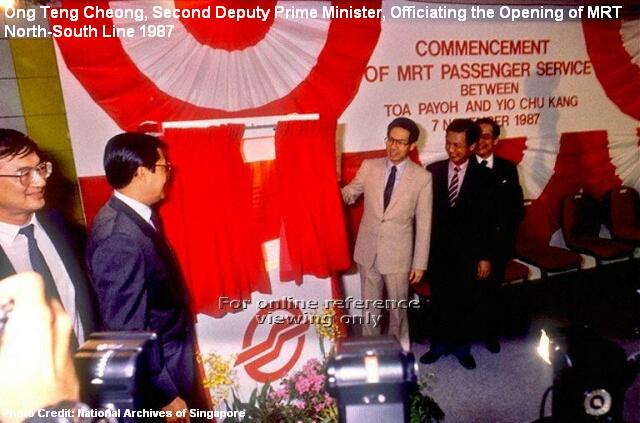
Many studies and reviews throughout the 1970s
The 1967 proposal set the MRT system down on a long and winding road.
Building an MRT system meant massive spending in one of the costliest projects ever undertaken by the government, during a time in independent Singapore's early years when other issues like housing, defence, and education also required urgent attention.
Overseas experts were brought in to conduct reviews on the feasibility of the proposed system. These included experts from American consultancy Wilbur Smith and Associates (1972), the World Bank (mid-1970s), and a team from Harvard University (late-1970s).
PM Lee Hsien Loong, who was a student at Harvard in the late 1970s recalls in a speech on the Downtown Line in 2013:
"At that time, I was studying in Harvard. I got a message from home asking me to get in touch with a professor in Harvard – Kenneth Hansen, and he was a professor in transport economics. I asked him whether he would come to Singapore to do a study and advise us on the merits and the ways we could expand our public transport system. So he came to Singapore, he brought a team, he did a study, and he recommended an all-bus system."
Apart from foreign experts, government ministries, such as the Ministry of National Development (1976) and Ministry of Defence (1978), and several different government committees also separately studied various aspects of having an MRT system.
Despite the various studies and reviews, no firm conclusion could be drawn, and opinions were divided.
[related_story]
Strong opposition to the MRT system in early 1980s
Ong Teng Cheong served as the Minister for Communications, which also oversaw the transport portfolio in those days, from 1978 to 1985. The then proposed MRT system underwent its most critical period during Ong's tenure.
Ong was a strong proponent of building an MRT system, ever since he was part of the planning team that proposed it in 1967.
But he faced strong opposition to the idea of the MRT system.
 Ong Teng Cheong. Source: NAS
Ong Teng Cheong. Source: NAS
One major person against it was first generation leader Goh Keng Swee, who was the deputy prime minister, and Ong's cabinet senior back then. Goh was concerned about the project's massive cost.
He also favoured the development of the all-bus system recommended by the Harvard team.
[caption id="" align="aligncenter" width="161"] Goh Keng Swee. Source: Wikipedia[/caption]
Goh Keng Swee. Source: Wikipedia[/caption]
A televised debate that pitted Goh's Harvard professors against Ong's transport planner and consultant Bruno Wildermuth took place in 1980. The debate was presided over by then prime minister Lee Kuan Yew.
Another notable person who was cautious about the government rushing into the project was former president Tony Tan, who was the trade and industry minister in 1981.
During a forum on economic affairs at the National University of Singapore, Tan said that emphasis should be placed on building public housing rather than on the MRT system.
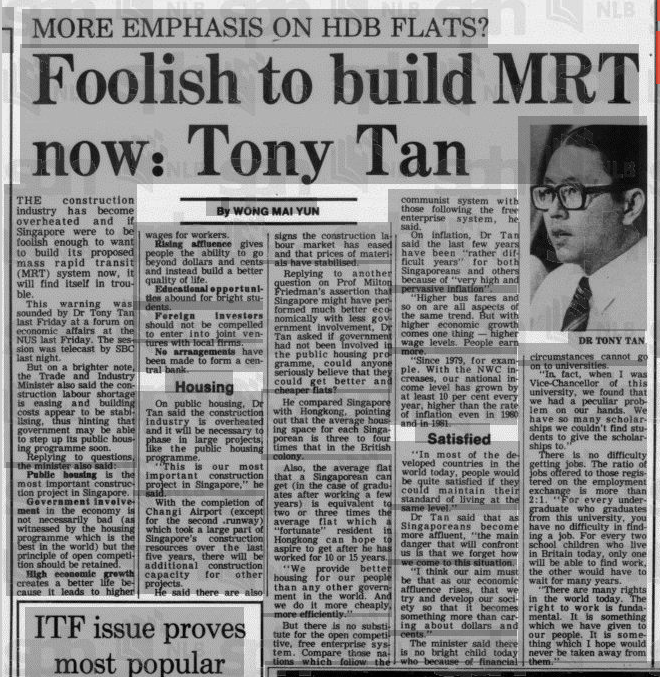 ST, Dec. 17, 1981. Source: NewspaperSG
ST, Dec. 17, 1981. Source: NewspaperSG
Soldiering on
Despite the strong opposition against the MRT system, Ong soldiered on.
In 1980, he set up the Provisional Mass Rapid Transit Authority to take on and oversee the preparatory work for the possible construction of the MRT system.
He also took the opportunity to talk about the MRT system in several of his public speeches.
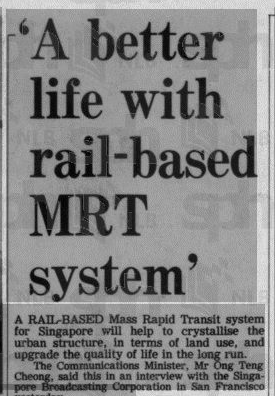 ST, Sep. 30, 1980. Source: NewspaperSG
ST, Sep. 30, 1980. Source: NewspaperSG
Dwelling on the topic during a National Day dinner in his constituency of Kim Keat, he spoke on how the MRT would improve Singaporeans' quality of life:
"Certainly, the MRT can contribute to the growth and vitality of a city and allow for more intensive development and better economies of scale. New York, London or Tokyo would not be able to support the amount of urban and economic activity that they do today without their subway systems.
Apart from its mass transportation capability, MRT would also represent a quantum leap in the quality of public transport. The comfort, efficiency and reliability of MRT would make urban travel less burdensome, and enable us to make more meaningful use of our time.
It would, in short, represent an altogether new dimension in urban mobility that would revolutionise living habits and lifestyles in much the same way as the aeroplane which has added a new dimension in international travel."
Ong went beyond just selling the MRT based on the benefit of improved urban mobility. He also pointed out the likelihood that the MRT would benefit commercial development and the economy.
In a speech at the Singapore Institute of Architects' Annual Dinner in 1980, he explored the idea of intensified commercial development in urban centres that would be served by the MRT:
"This is the practice in most large cities and I suppose they have several good reasons for doing so. The main advantage, of course, is that people can commute quickly and reliably to and from these large activity centres. Each centre can be made to be as self-contained as possible. The commuter having made the journey to these centres will then be able to perform as many activities as possible without having to commute to other places. The other advantage is that the owner and operator of the MRT system will be able to cream off some revenue from those developments to finance his own operations."
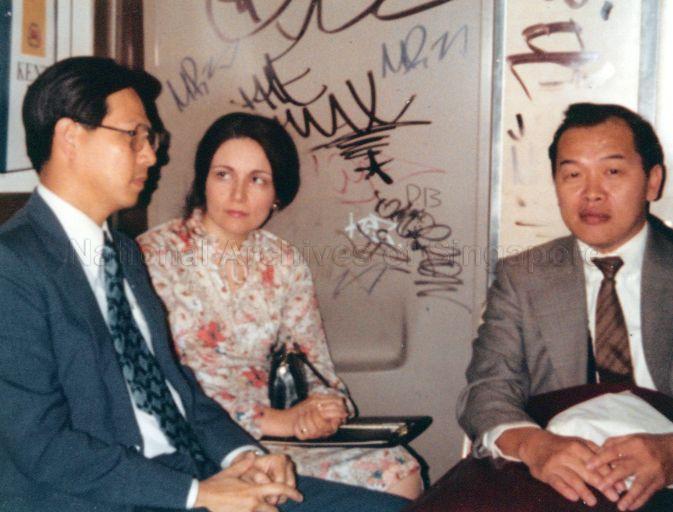 Ong Teng Cheong (1st from left) on a Mass Transit study trip in New York.
Ong Teng Cheong (1st from left) on a Mass Transit study trip in New York.
Ong also travelled widely to various developed cities to study why their urban rail systems were built and what benefits were derived from them.
After bringing up various observations in his speech at the Australian Alumni Silver Anniversary Dinner in 1980, he said:
"What lessons can we learn from those cities? The first, I would say is that an MRT has a tremendous influence in shaping the growth and development of a city. Nowhere is this more evident than in Toronto. From the air, one can guess the MRT alignment by the cluster of high-rise development in and around the underground stations. Another good example is Montreal where there is virtually an entire city underground with air-conditioned shops using the subways and linking the stations to hotels, office buildings and shopping complexes."
Decision taken to build the MRT system
As history would have it, the government gave the go-ahead to build the MRT in 1981, following the Comprehensive Traffic Study, which found that an all-bus system was not practical after all.
Ong would later declare in 1982 that:
"The Government has now taken a firm decision to build the MRT. The MRT is much more than a transport investment, and must be viewed in its wider economic perspective. The boost it'll provide to long term investors' confidence, the multiplier effect and how MRT will lead to the enhancement of the intrinsic value of Singapore's real estate are spin-offs that cannot be ignored."
Years later on Nov. 7, 1987, Singapore’s Mass Rapid Transit (MRT) system began operations.
Everything went well for many years from then on till the disruptions started.
Top image from NAS
If you like what you read, follow us on Facebook, Instagram, Twitter and Telegram to get the latest updates.
